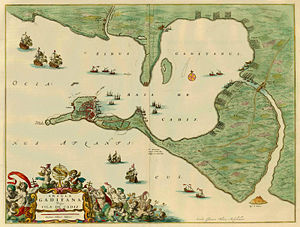Capture of Cádiz
| Capture of Cadiz | |||||||
|---|---|---|---|---|---|---|---|
| Part of the Anglo–Spanish War (1585) | |||||||
 Map of the Bay of Cádiz, 17th century. |
|||||||
|
|||||||
| Belligerents | |||||||
|
|
|
||||||
| Commanders and leaders | |||||||
|
|
|
||||||
| Strength | |||||||
| 40 ships and 5,000 men | 150 ships and 14,000 men | ||||||
| Casualties and losses | |||||||
| 32 ships scuttled or sunk | 3 galleons sunk or burnt, 2 other ships sunk, 5 other ships captured, ~2,000 killed |
||||||
The Capture of Cádiz in 1596 was an event during the Anglo-Spanish War, when English and Dutch troops under Robert Devereux, 2nd Earl of Essex and a large Anglo-Dutch fleet under Charles Howard, 1st Earl of Nottingham, with support from the Dutch United Provinces, raided the Spanish city of Cádiz.
Due to the Spanish commander's lack of foresight and organisation, the Anglo-Dutch forces met little resistance. In order to deny the raiders their prize the Spanish set fire to their fleet anchored in the Bay of Cádiz; the attacking forces disembarked, captured, sacked and burned the city and took hostage several of the city's prominent citizens, who were taken back to England to await payment of their ransom.
The economic losses caused during the sacking were numerous: the city was burned, as was the fleet, in what was one of the principal English victories in the course of the war. Despite its failure in its primary objective of seizing the Spanish treasure fleet's silver, the raid contributed to Spain's declaration of bankruptcy the following year.
On 13 June 1596 the fleet set sail from Plymouth. The fleet comprised 150 English and Dutch ships, 17 of which belonged to the Royal Navy, divided into four squads with 6,360 private soldiers, 1,000 English volunteers, and 6,772 sailors.
Charles Howard, 1st Earl of Nottingham was the admiral commanding the fleet, while the landing forces were under the command of Robert Devereux, 2nd Earl of Essex, Lord Thomas Howard, Sir Walter Raleigh, and Sir Francis Vere each commanding a squad. Anthony Ashley was the Clerk of the Privy Council and was a representative of Queen Elizabeth I of England. Cristóvão and Manuel of Portugal, sons of António of Portugal, and supposedly Antonio Pérez, were also on board, although without command. These forces were joined by another 20 ships from the United Provinces, with 2,000 men on board, who under the command of Admiral John de Duyvenvoorde, Lord of Warmond, were put under English orders.
...
Wikipedia
